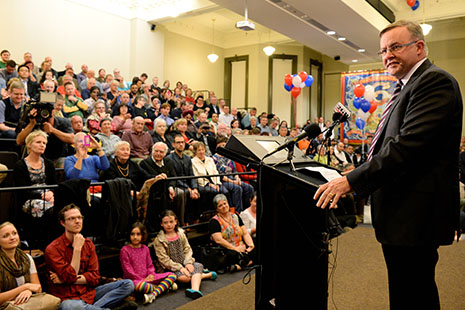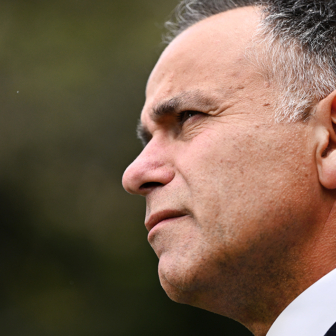THE failure of the Labor Party to tear itself apart after its defeat last month provides a stunning contrast with the acrimony that followed its last such disappointment in 2004. Indeed, there has been more sweetness and light over the past few weeks than after the 2010 election, when the party managed to hang onto power. Julia Gillard can claim some of the credit. Her dignified silence during the campaign provided a stark contrast with the barely concealed fury of Kevin Rudd during the 2010 campaign. And the highly damaging leaks that helped wreck Gillard’s chances of scraping together a majority in 2010 had no equivalent this time round.
But Rudd also deserves some credit. The civility that has so far followed the 2013 election defeat has much to do with what might turn out to be the only decision of any lasting significance to emerge from his brief return to the prime ministership: the decision to permit Labor Party members a vote in the election for federal leader.
The reform has not been without its internal critics. The requirement that a leadership ballot can only be triggered if 75 per cent of caucus members withdraw their support from a serving leader struck some observers as excessive, providing any but the most incompetent or unpopular leader with a virtual guarantee of tenure between elections. Unkind critics attributed the provision to Rudd’s own desire for self-preservation second time round; those more inclined to psychoanalytical explanation suggested that Rudd, by setting the bar so high, was telling the world (and especially his party) precisely what he thought of his treatment at its hands in June 2010.
When it met in Balmain for a special meeting in July, caucus adopted a lower threshold for when it is out of government – only 60 per cent would be required to vote out a Labor opposition leader – but even then removal would be well nigh impossible. In view of the leadership churn of recent years, however, there are perhaps arguments for erring on the side of stability.
A few critics wondered why, unlike in Labour Party leadership elections in Britain, members of affiliated unions would not be permitted to vote. But unions not being the flavour of the month these days – especially in connection with the affairs of the Labor Party – no one but a few disgruntled union officials ran with that objection.
The haste with which the matter was pushed through caucus before the election inevitably resulted in quite a bit of fuzziness at the edges, not least about the matter of who would be footing the bill for the contest. Caucus might have adopted the proposal, but it would be the party organisation, which had been given no say in the matter, that would be expected to pay for it. So, when Labor Party members received their ballot paper asking them to vote in the election, they were also invited to contribute to defraying its cost.
These loose threads might have tempted some people to agree with Senator Stephen Conroy’s claim that the new rules were a “farce,” except for the fact that his record as a notorious factional warlord should automatically disqualify him from offering any opinion on efforts to reduce the power of notorious factional warlords. Not that he need worry too much; while unions continue to control half the votes at party conferences, the factions’ control of the party will remain secure. All the same, it is easy enough to sympathise with Labor Party oligarchs who find a bit of democracy, and its attendant uncertainty, a little unsettling.
Whatever else it has or hasn’t achieved, the contest between Bill Shorten and Anthony Albanese has been successful in discouraging factional strife. The unusually large number of seats that came up for grabs after the resignations from the Gillard–Rudd government in the final year of its life set off predictable factional brawling, even if the party managed to keep a lid on dissent while Kevin Rudd spent a few weeks pretending that he was going to lead his party to an unexpected victory. What was less predictable was that the leadership contest has not only resulted in politeness between Left and Right factions, but also seemed to heal – at least for the time being – the often even more bitter divisions within the factions.
The Right has, more or less, united behind Shorten, the Left behind Albanese. But best of all for those who believe in a democratic Labor Party, this situation does not make the result predictable. Caucus is seen as likely to vote for Shorten, while a majority of the party membership – less certainly – is expected to swing behind Albanese. But no one really knows: since this is the first time the 44,000 members of the Labor Party have been asked for their opinion on such a matter, the result is far from foregone.
The contest itself has surely been one of the more positive happenings in Australian politics in the last generation, and the contestants themselves can take some credit for the apparent success of the venture. Both Shorten and Albanese have been sensible in not attempting to turn the affair into a major contest over policy. Neither is in a position to commit the party to a particular agenda over the next three years and, since they are also committed to caucus election of ministers, they cannot even say who will serve with them as frontbenchers (although each is clear that he wants the other to serve with him, whatever the outcome).
There has been cynical and even hostile commentary from the media about the lack of real policy differences between the two. But what did they expect? When policy differences between the parties are often hard to discern, why should one expect to see a chasm between two contenders for the leadership of the same party? That they come from different factions doesn’t affect this question. It’s a long time since Labor’s factions represented coherent ideological positions.
Because the contest is over who is best suited to lead the party, much comes down to personal style and track record. Albanese presents himself as a classic Australian everyman, made more interesting by his Italian background – he gave an impressive lesson to Tony Jones on Q&A in how to pronounce his name properly – and his having been raised in public housing by a single mother on a disability pension. Shorten’s backstory is perhaps a bit less interesting and less obviously “Labor,” but he makes much of his mother’s successes as a mature-age university graduate, teacher and academic. Fathers are either inconspicuous or absent from these stories, although Shorten has connected his support for immigration to his father’s status as an English migrant.
Shorten – the ex–Australian Workers’ Union leader – presents himself as modest, quietly spoken and statesmanlike, and talks of empowering “the powerless.” Albanese’s style is more effusive and less prime ministerial: he presents as a scrapper, someone who will be able to take the fight up to Abbott as opposition leader. Shorten offers himself not as a candidate for leader of the opposition but as an alternative prime minister. Albanese points to his exemplary record, as leader of the house in the Gillard government, of getting Labor bills through a House of Representatives the party didn’t control. Shorten says he can turn “minorities into majorities,” referring especially to his role in establishing the National Disability Insurance Scheme, but also with an obvious eye to Labor “minority” at the 2013 election, which will need to be turned into a “majority” by 2016 if it is to govern again.
Whatever the result of the contest, there will be plenty of media commentary on what a disaster it has all been for Labor. An outcome that sees the election of a leader favoured by the rank and file but not a majority of caucus will particularly delight the conservative – meaning Murdoch – press, just as its British arm was delighted to label Ed Miliband in Britain as “Red Ed” when he came to the Labour leadership with the strong support of unions but lacking a majority of the parliamentary party. But Australian Labor’s adoption of leadership elections necessarily conceded the possibility of this kind of outcome, at which – if it comes to pass – party power-brokers can shrug and blame “the people.”
Or, if they think the Labor Party membership insufficiently representative to be considered “the people,” they can blame themselves for allowing the party below to so wither away that its opinion on who should lead the country might be dismissed as anomalous. •




